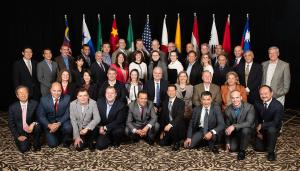Founded in 1960, the U.S. Grains Council develops export markets for U.S. barley, corn sorghum and their value-added products through tailored programs that meet an individual country’s culture and needs. USGC’s technical programs teach livestock and poultry producers how to use coarse grains effectively and manage their operations efficiently. Its trade servicing efforts educate potential and current customers about the U.S. marketing system, including financing, government programs, U.S. coarse grains quality and prices. USGC’s trade policy initiatives identify foreign barriers to U.S. coarse grains exports.
Export Exchange 2014 is just one example of numerous programs the U.S. Grains Council hosted this year to facilitate networking that will build relationships and ultimately grow our members’ and buyers’ business.
Promoting the Value of Trade
The Council’s work goes beyond conferences like Export Exchange. In 2014, the Council began assessing markets for potential U.S. ethanol exports; worked with Tanzanian livestock associations to expand their industry; provided technical information about low-oil distiller’s dried grains with solubles (DDGS) to Japanese customers; promoted biotechnology’s benefits through initiatives like MAIZALL; and released its Corn Harvest Quality Report and Export Cargo Quality Report.
These programs have helped make the United States a top coarse grain exports. In the 54 years the Council has been operating, U.S. coarse grains exports have increased by more than 400 percent.
More Than Just a Conference
Many Export Exchange and USGC trade team participants expressed a continuing preference for buying U.S. grains due to the consistency and quality of the grain and the transparency and reliability of the U.S. marketing and delivery systems. USGC programs helped build these buyers’ trust in the U.S. marketing system.
The Council, as the trusted bridge between international customers and U.S. agriculture, will continue to provide customer education on grain supply, use and reliability.
“It’s one thing to sit in a conference and hear industry and government leaders talk about how U.S. producers and suppliers have an abundant supply of high-quality coarse grains and co-products available for export,” said U.S. Grains Council President and CEO Tom Sleight. “Export Exchange and other Council programs provide that, and more. But there is still no substitute for the ground truth you get from getting out into the field, and talking directly to farmers and exporters.”


